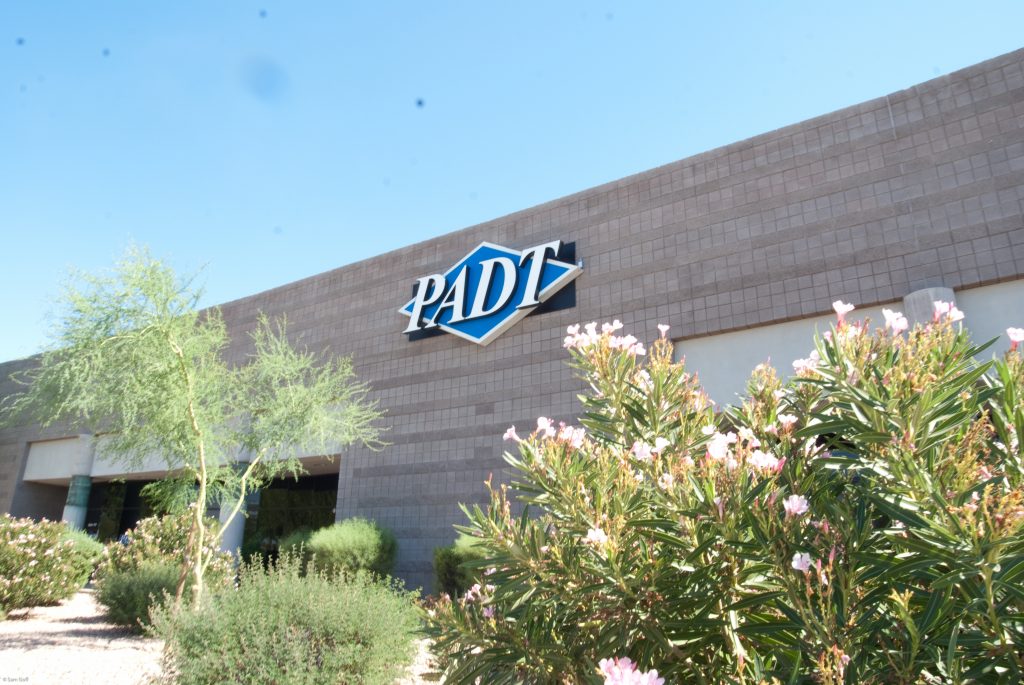In the primordial soup of 3D printing, in the the 1990’s a group of Allied Signal engineers were using simulation and 3D printing to design turbine engines. This group saw the potential that 3D printing had, only a few years after the technology had been commercialized. They formed PADT in 1994. The team bought an SLA 250 and was in business producing prototypes and soon after complex manufacturing and design projects as well. Now the company additionally resells Stratasys equipment, sells and consults on ANSYS software, does 3D scanning as a service and does manufacturing for aerospace companies. The company also has a speciality in designing, developing and producing medical devices. PADT also is rumored to do very high end technically challenging research projects for acronym ridden parts of the US government. PADT today has gone from one of the world’s first service bureaus to a 25-year-old company with 95 employees with its own 44,000 Sq Ft ISO certified site. We interviewed 3D printing pioneer and PADT Co-Founder Eric Miller to find out more about the quarter of a century old company.

How did you get started in 3D printing?
One of PADT’s co-founders, Rey Chu, started the prototyping lab at AlliedSignal. That introduced him to Stereolithography. When we started PADT in 1994, we knew we wanted to make that technology a foundational part of our business, so we leased a system and set ourselves up as Arizona’s first service bureau
What were some of the problems back then?
Materials were limited, the software was basic, and the machines were not as robust as they are today. The big issue was just figuring out all the parameters that worked best.
Did you have to wait hours for files to slice?
Indeed, we did.

What types of parts did you make in the beginning?
We had a wide variety of parts from across industries, even early on. A lot of our early work was enclosures for electronics.
You’ve made over 100,000 prototypes for clients, which one was the hardest?
A pump housing. It was huge and made on an FDM machine, but it needed to be water tight. We could never get it to seal.
What kinds of simulation services do you offer? To whom?
Simulation, just like AM, was a core founding technology for PADT. We are an Elite ANSYS Channel partner selling and supporting the full line of ANSYS physics simulation tools. Stress, Thermal, Vibration, Heat Transfer, Fluid Flow, Electromagnetics (High and Low), and Multiphysics.

What kinds of products do you design?
A wide variety. We have worked on toys for infants and help redesigned avionics packages. But for this area of the company, we tend to concentrate on:
1. Custom rotating equipment like pumps, blowers, and turbines for difficult applications
2. Medical devices
3. Semiconductor manufacturing equipment
4. Packaging of commercial electronics
Many 3D printing services are limited to manufacturing, but you seem to be a one-stop shop?
PADT is about offering a complete solution to companies who design and manufacture physical products. So, we want to provide them with the tools and services they need to do that better. In fact, we recently added scanning as a service because customers kept wanting us to add that capability so they could get it done with us since we were already doing so much for them.
What kind of advice would you give me if I wanted to bring a 3D printed medical device to market?
1. Make sure it is a good idea on its own, with or without 3D Printing
2. Leverage the advantages of Additive Manufacturing in your design
3. Get Quality on board from day one, preferably someone that understands 3D Printing. Make sure your manufacturing process is ISO13485 from day one.
If I wanted a 3D printed end use product, what will be some of the pitfalls?
The answer to this question is so part dependent. But speaking generally surface finish is something you have to learn to live with for most production processes. Also, the as-built material properties may not be the same as for traditional methods, so make sure you can live with them. The other issue is post-processing. Make sure you consider the cost and time for dealing with parts after they leave the system.
What are the things holding 3D printing back?
Honestly, not much. It is growing at a good pace. Any faster and people might start tripping. I think the biggest holdup now is that we have not invented the processes or materials that we need for the next leap forward. High volume 3D printing with minimal post processing is needed the most.
You also do angel investing? In what types of firms?
Initially, in any type of tech company. Which turned out to be a mistake. Now we only invest in startups that design and manufacture hardware, and in an industry we really understand. Our three favorite Angel investments are Volumill, high speed machining software; Serious Integrated, a modular touch screen solution for machinery; and StreamDX, a medical device that measures urine flow in men from home… yes, I said urine.
Subscribe to Our Email Newsletter
Stay up-to-date on all the latest news from the 3D printing industry and receive information and offers from third party vendors.
You May Also Like
Why Corrosive Resistant Materials Are Important to the Success of 3D Printing Across Industries
The adoption of additive manufacturing (AM) is accelerating across many major industries. As this technological shift unfolds, the importance of corrosion resistance has emerged as a challenge for 3D printing...
America Makes Announces IMPACT 2.0: $6.6M in New 3D Printing Funding
America Makes, the Manufacturing Innovation Institute (MII) based in Youngstown, Ohio, has announced IMPACT (Improvement in Manufacturing Productivity via Additive Capabilities and Techno-Economic Analysis) 2.0, a project call which will...
3D Printing Webinar and Event Roundup: April 14, 2024
We’re starting off the week’s 3D printing webinars and events at ASTM AMCOE’s 11th Snapshot Workshop and MACH Exhibition. Stratasys continues its advanced training courses, SME is holding a virtual...
AMUK Welcomes Airframe Designs as British 3D Printing Industry Grows
While the UK is not the hub for 3D printer and materials manufacturers as other nations, the country continues to excel at the research, development, and application of additive manufacturing...































